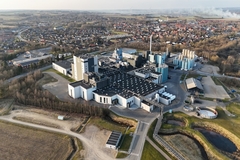
- Industry news
Industry news
- Category news
Category news
- Reports
- Key trends
- Multimedia
- Journal
- Events
- Suppliers
- Home
- Industry news
Industry news
- Category news
Category news
- Reports
- Key trends
- Multimedia
- Events
- Suppliers
F&B digital divide: Tech gaps and outdated systems stifle industry potential, finds study

AI and digital tools are fueling F&B innovation, helping brands speed R&D, streamline compliance, and uncover insights amid economic uncertainty and supply chain volatility. But while NPD investment is rising, a report reveals that outdated manual systems continue to hold innovation back.
Despite 83% of brands planning to boost NPD this year, only 2% say their product development processes are “fully digitized,” according to a report by TraceGains, which provides compliance, quality, and innovation solutions for the F&B industry.
The company surveyed 190 small and large F&B firms virtually worldwide from June 16 to July 21 this year.
The findings depict AI and tech adoption as growing but fragmented. Without digitized foundations, their impact is limited. Infrastructure is the bottleneck, with most teams stuck with spreadsheets and manual workflows, hindering speed and collaboration.

“Spreadsheets do have a strength in that they’re highly configurable. In the hands of a skilled food scientist, a spreadsheet can be a sophisticated tool for calculation and formula development,” Paul Bradley, senior director of Product Marketing at TraceGains, tells Food Ingredients First.
“Where spreadsheets fall down is in workflow, collaboration, version control, change management, and support for artificial intelligence applications, all of which are increasingly important in an interconnected F&B industry.”
 AI can help in sourcing by helping brands identify alternative ingredients and suppliers, says Bradley.
AI can help in sourcing by helping brands identify alternative ingredients and suppliers, says Bradley.
Leveraging AI “excitement”
The report highlights a “genuine excitement” around AI and digital transformation. Innova Market Insights data also indicates heightened consumer interest in AI’s involvement in F&B production. Nearly 41% see potential in using AI to develop products.
However, Bradley says progress is being throttled by outdated workflows and a lack of automation. “Amid intense pressure to compete by offering healthier, more sustainable products the majority of brands still operate in the stone age managing product development with emails, spreadsheets, and paper files.”
While 17% of companies are “all in” on AI (up from 10% in 2024), 36% are not using AI at all. Market insights (24.7%), formulation acceleration (9%), and compliance streamlining (9.5%) are the top areas attracting AI usage in companies.
“There are many applications for AI in NPD, but three key use cases are generating real excitement. First, AI can play a powerful role in sourcing, helping brands identify alternative ingredients and find qualified suppliers, backed by global intelligence data that can help manage the risk of building new supplier relationships,” says Bradley.
“Second, it can play a role in formulation, helping to identify alternative ingredients, or to solve complex, multi-objective optimization scenarios that would be time-consuming and difficult for R&D teams to tackle on their own.”
AI can also speed up the extraction of data from “disparate, non-standard documents” to accelerate the path toward digitization. This will help NPD, quality, compliance, and regulatory, he adds.
 Despite rising budgets and growing urgency, the F&B industry remains deeply reliant on manual workflows, hindering speed and accuracy.
Despite rising budgets and growing urgency, the F&B industry remains deeply reliant on manual workflows, hindering speed and accuracy.
Manual process barrier
Skepticism over AI’s usage is dropping, with only 32% remaining unconvinced, compared to 44% last year, says the report. Yet, 36% still don’t use AI in their NPD process.
Nearly 56% of teams are still “somewhat reliant” on manual tools, with only 16% transitioning to digitized systems.
Bradley explains what could be sustaining this gap: “There is often work to be done to collect data and documents from legacy systems, especially if that information hasn’t been well-maintained. That said, teams who do so often find real value in the cleanup exercise.”
“The good news is that AI-powered data extraction is becoming a powerful tool for digitizing legacy documents, making this burden much lighter.”
Overcoming outdated methods
Companies are financing technology upgrades, and 40% are more likely to invest in them due to global trade volatility. Some 18% prioritize upgrades or maintenance of existing systems, while 13% will focus on compliance tech to deal with regulatory uncertainty.
Such trends point to tech investment being reactive, not strategic, mainly focused on short-term risk mitigation. Very few are building future-proof digital strategies.
 The F&B industry needs to work together to overcome the digital gap challenge.Additionally, legacy workflows, disconnected systems, and manual processes slow innovation, leaving teams reliant on outdated tools unsuited for today’s fast-paced product development.
The F&B industry needs to work together to overcome the digital gap challenge.Additionally, legacy workflows, disconnected systems, and manual processes slow innovation, leaving teams reliant on outdated tools unsuited for today’s fast-paced product development.
Bradley expects lagging technology adoption to continue to be a source of risk even as the industry offers exciting changes due to digitalization in the future.
“The divide between brands with a strong digital strategy and brands still holding onto legacy processes is only going to grow, and it’s hard to overstate how quickly things like AI are advancing in F&B,” says Bradley.
He calls for the industry to come together as a whole around the real risks created by the digital gap.
“Fragmented data sources and manual processes don’t just stand in the way of innovation; they also make traceability and public health objectives harder to reach, while putting consumers at risk from supply chain disruptions.”










